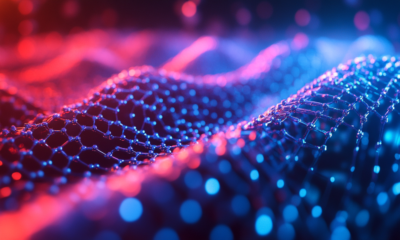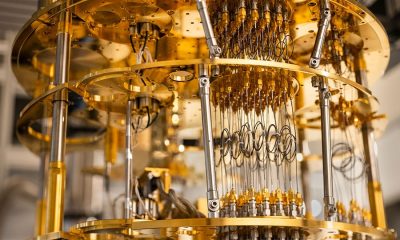Artificiell intelligens
Träna AI med optisk fiber: Ett ljusbaserat språng
Securities.io har rigorösa redaktionella standarder och kan få ersättning från granskade länkar. Vi är inte en registrerad investeringsrådgivare och detta är inte investeringsrådgivning. Vänligen se vår anknytning till anknytning.

Why Optical Fiber Could Replace Electricity in AI Computing
Sedan de första dagarna av databehandling, almost all computers have been based on calculations using electricity in one way or another, from antique vacuum tubes to modern nanometer-scale silicon chips.
As silicon chips get smaller and smaller, researchers have been looking at new ways to build computers that could push our capacity further than silicon chips, a topic we explored in “Topp 10 icke-kisel datorföretag".
These methods include using different materials, like carbon carbide, vanadium dioxide, organic materials, or graphene, for example. Another way is to change how computing is done, moving away from the binary programming of electricity-based computing, which includes quantum computing and photonics.
Photonics uses light instead of electricity to encode and transfer information. However, until now, it has still been ultimately converted into a binary signal, failing to form a purely light-based form of computation.
This has changed with the work of researchers at the Tampere University (Finland) and Université Marie et Louis Pasteur (Besançon, France). They used optical fiber for ultrafast calculations and published their findings in the scientific journal Optics Letters1, under rubriken "Limits of nonlinear and dispersive fiber propagation for an optical fiber-based extreme learning machine".
Limitations of Traditional AI Training With Electronic Systems
AI training and data processing are reaching limits in terms of efficiency, with AI computation increasingly constrained by energy consumption and the speed of data processing.
In contrast, light-based calculations have the potential to be thousands of times quicker and can encode data into tiny differences of energy, making it more efficient. The issue is that so far, no direct calculation using light has been performed.
The researchers' work used a particular class of computing architecture known as an Extreme Learning Machine, (ELM) an approach inspired by neural networks.
Among some of their advantages, ELMs can learn from the training data in one step and are a relatively simple algorithm.
As a rule, ELM is unlikely to be useful for very complex tasks requiring multiple layers of AI training, but can perform very well and more efficiently for specific tasks, like visual recognition for example.
How Researchers Encoded Images Using Optical Fibers
The researchers used femtosecond laser pulses (a billion times shorter than a camera flash) and an optical fiber confining light in an area smaller than a fraction of human hair to build an optical ELM system.
The laser pulses are short enough to contain a large number of different wavelengths or colors, creating a rich dataset.
They then sent these data into the fiber with a relative delay encoded according to an image.

Källa: Tammerfors universitet
The Role of Nonlinear Optics in AI Processing
This form of data encoding was transformed by the nonlinear interaction of light and glass.
Linear optics is the regular optics taught in school, where the light directly interacts with a prism, for example.
Inom icke-linjär optik beror reaktionen hos mediet som ljuset passerar i på ljusets våglängd, intensitet, riktning och polarisering.
Nonlinear optical components can cause photons of different frequencies to combine and create new photons at new frequencies.
“Instead of using conventional electronics and algorithms, computation is achieved by taking advantage of the nonlinear interaction between intense light pulses and the glass.”
Mathilde Hary and Andrei Ermolaev – Post-Doctoral Researchers
Non-linear interaction and Extreme Learning Machine (ELM) algorithm was able to train an AI to classify handwritten digits (like those used in the popular MNIST AI benchmark).

Källa: Optikbokstäver
The best systems reached an accuracy of over 91%, close to the state-of-the-art digital methods.
What makes the result exceptional is that it was achieved in under one picosecond, or one trillionth of a second (0.000000000001 seconds).
Ideal Optimization
The best results did not occur at the maximum level of nonlinear interaction or complexity.
Instead, they required a delicate balance between fiber length, dispersion (the propagation speed difference between different wavelengths), and power levels.
“Performance is not simply matter of pushing more power through the fiber. It depends on how precisely the light is initially structured, in other words how information is encoded, and how it interacts with the fiber properties.”
Are Optical Fiber Computers the Future of AI?
Training AIs with only light is a radical departure from all the methods used until now. This is likely not going to be a method possible to use for every type of data, but for the ones where it can be applied, this could bring results that are 1,000x more efficient in terms of energy, and as much as a million times quicker.
“Our models show how dispersion, nonlinearity and even quantum noise influence performance, providing critical knowledge for designing the next generation of hybrid optical-electronic AI systems.”
Most likely, such an approach would mean that some AI calculation would be delegated to a non-linear optical fiber hardware custom-built for the task. So repetitive tasks, like visual identification, would be the best candidates more than processing new data.
“This work demonstrates how fundamental research in nonlinear fiber optics can drive new approaches to computation. By merging physics and machine learning, we are opening new paths toward ultrafast and energy-efficient AI hardware.
Potential applications range from real-time signal processing to environmental monitoring and high-speed AI inference.
Such work is, however, still at the demonstration of basic principles of the technique stage, and far from a commercialization step.
It nevertheless demonstrates that photonics is likely going to be an increasingly important part of the computing industry moving forward, as light can be superior to electricity for some computing applications due to fundamental physics reasons.
Top Publicly Traded Laser & Photonics Company
Koherent (II-VI Marlow)En ledare inom laserinnovation
Coherent, Inc. (COHR + 4.21%)
Coherent är ett stort industrikonglomerat med över 26,000 XNUMX anställda och en ledande aktör inom laserteknik. Det uppstod genom sammanslagningen av det avancerade materialet II-VI Marlow med lasertillverkaren Coherent.
Företaget är expert på avancerade material som används i laser, optik och fotonik, såsom indiumfosfid, epitaxiella wafers och galliumarsenid.
It grew largely thanks to multiple acquisitions over the last decade, from $600M in revenues in 2013 to $4.7B in 2024.
The company derives 29% of its revenues from lasers directly, with the rest linked to associated equipment like optical fiber, and electronics. The instrumentation category mostly includes life
sciences and medical applications.

Källa: Sammanhängande
Närvaron av företaget i avancerade material som termofotovoltaik (som diskuterade vi i en tidigare artikel), silicon carbide, lasers, and electronics helps it benefit from structural trends like the growth of precision manufacturing, additive manufacturing (3D printing), electrification, and renewable energies.
Företaget har nyligen separerade sin kiselkarbidverksamhet till en ny enhet, som ägs till 75 % av Coherent, medan resten ägs lika av dess partners Mitsubishi Electric (vilket ger kiselkarbid-kraftleverantörer) och Denso (vilket ger dess verksamhet som leverantör av elektrifiering och krafthalvledare till fordonsindustrin).
Detta beror på att kiselkarbid i allt högre grad är sin egen teknik, mestadels används i högeffektapplikationer som elbilar, batterier och förnybar energi.
Coherent är en ledare i LIDAR och 3D-digital avkänning, inklusive för självkörande applikationer, bioteknik Next Generation Sequencing (NGS) flödescelleroch lasrar för halvledartillverkningDen förväntar sig att dess huvudmarknader kommer att växa med 8–20 %.

Källa: Sammanhängande
The other potential new applications of lasers, like direct energy weapons, photonic computing, nuclear fusion, and spacetech, could all equally help sustain the long-term growth of the company.
Sammantaget är Coherent så nära som det kan komma ett "pure play" börsnoterat laserföretag för investerare som är intresserade av sektorn, med stark vertikal integration och 3,100 XNUMX+ patent som skyddar dess innovationer.
As photonics progresses, it will progressively increase the demand for ultra-fast, ultra-precise laser systems, as well as lasers used in optical telecommunications.
Senaste Coherent (COHR) aktienyheter och utvecklingar
Studierefererad
1. Andrei V. Ermolaev, Mathilde HaryEt al. Limits of nonlinear and dispersive fiber propagation for an optical fiber-based extreme learning machine. Optik bokstäver. Vol. 50, Issue 13, pp. 4166-4169 (2025) https://doi.org/10.1364/OL.562186















